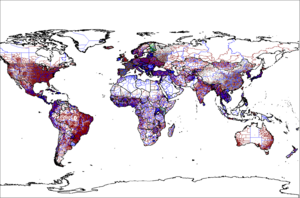Administrative division facts for kids
An administrative division is like a special area within a country that helps manage land and people. Think of it as a smaller section of a country, set up to make things easier to organize. These areas often have their own local government, which means they can make some decisions for themselves, but they are still part of the larger country. It's a way to break down a big country into smaller, easier-to-handle parts.
Contents
Why do countries have administrative divisions?
Countries use administrative divisions for many reasons. It helps them:
- Manage services: It's easier to provide things like schools, hospitals, and police services to smaller areas.
- Govern locally: People in a local area can have a say in decisions that affect their daily lives.
- Organize elections: Dividing a country into smaller areas makes it simpler to hold elections and count votes.
- Collect taxes: Local governments can collect taxes to pay for local services.
Different types of divisions
Countries around the world use many different names for their administrative divisions. Some common ones you might hear are states, provinces, counties, and districts. These divisions can also be at different "levels." For example, a country might have states (first level), and then those states might be divided into counties (second level), and counties into towns (third level).
States
Many large countries use "states" as their main administrative division. These are usually the first level of division.
- In the United States, there are 50 states, like California or Texas.
- Australia has 6 states.
- Germany has 16 states, called Länder.
- India has 27 states.
Provinces
"Provinces" are another common first-level division, especially in countries that were once part of empires.
- Canada has 10 provinces, such as Ontario and British Columbia.
- Argentina has 23 provinces.
- China has 22 provinces.
- South Africa has 9 provinces.
Counties
"Counties" are often a second-level division, meaning they are inside a larger state or province.
- In the United States, states are divided into counties. There are almost 3,000 counties across the country.
- The United Kingdom also uses counties.
- Some countries, like Croatia and Norway, use counties as their first level of division.
Districts
"Districts" can be found at different levels, depending on the country. They are usually smaller than states or provinces.
- Austria has about 100 districts.
- Bangladesh has 64 districts.
- In Switzerland, districts are a second-level division.
Departments
Many countries, especially those influenced by French administration, use "departments."
- France has 100 departments, which are a second-level division.
- Countries like Bolivia, Haiti, and Uruguay use departments as their first level of division.
Municipalities
A "municipality" usually refers to a city, town, or a small local area with its own government.
- In Croatia, municipalities are a second-level division.
- Libya and Mongolia use municipalities as a first-level division.
Other types of divisions
There are many other names for administrative divisions around the world. Some examples include:
- Autonomous communities: Like in Spain, where regions have a lot of self-rule.
- Cantons: Used in Switzerland as a first-level division.
- Communes: Often very small local areas, like in France.
- Governorates: Common in countries in the Middle East, like Egypt and Iraq.
- Parishes: Used in some smaller island nations like Barbados and Grenada.
- Prefectures: Like the 47 prefectures in Japan.
- Regions: Used in countries like Italy and France.
- Territories: Areas that might not have the same level of self-government as states or provinces, like in Australia or Canada.
Compare
- Country (a national or supra-national entity)
- Empire (a supra-national entity)
- State (a national or supra-national entity)
Related pages
- ISO 3166-2 Codes for the representation of names of countries and their subdivisions — Part 2
See also
 In Spanish: Demarcación administrativa para niños
In Spanish: Demarcación administrativa para niños


